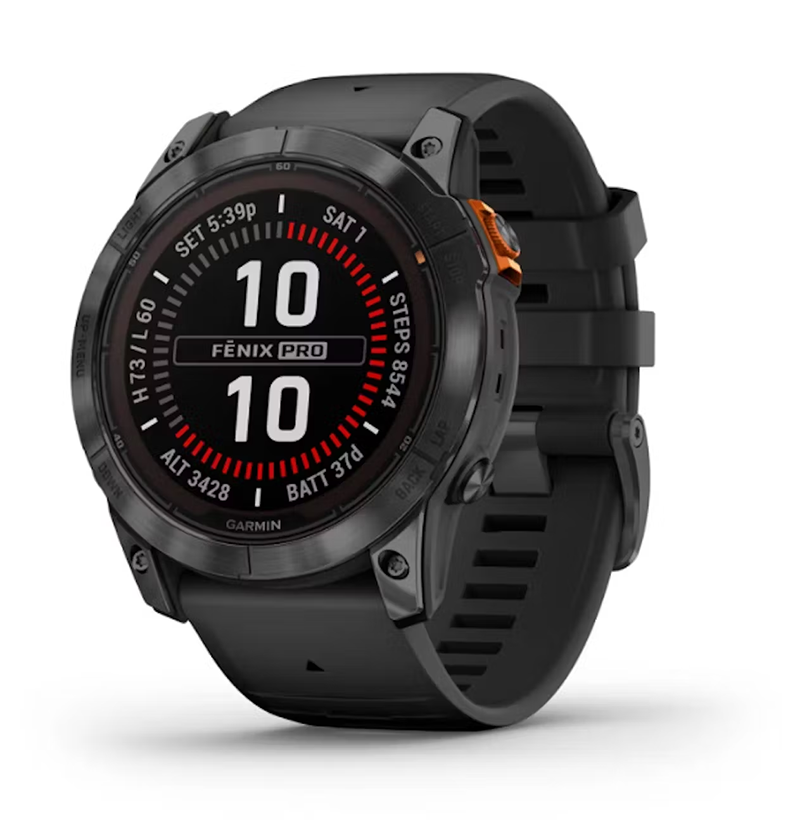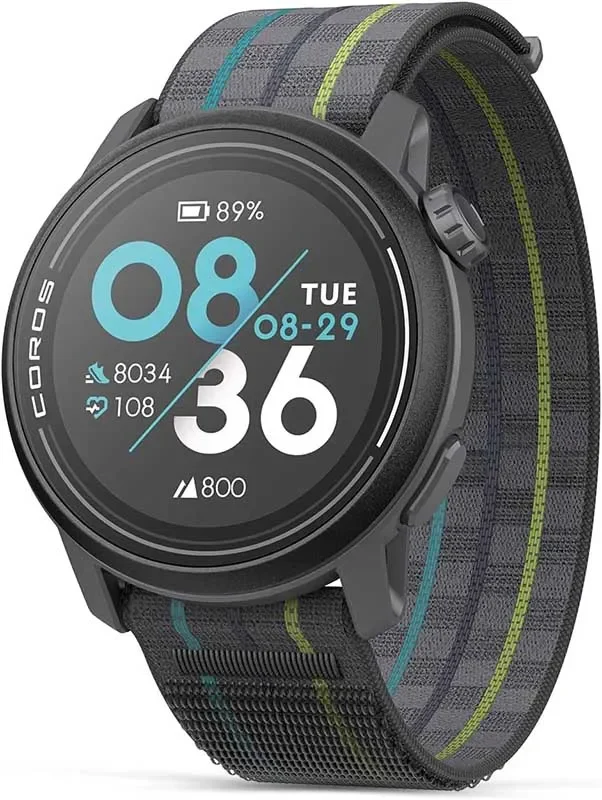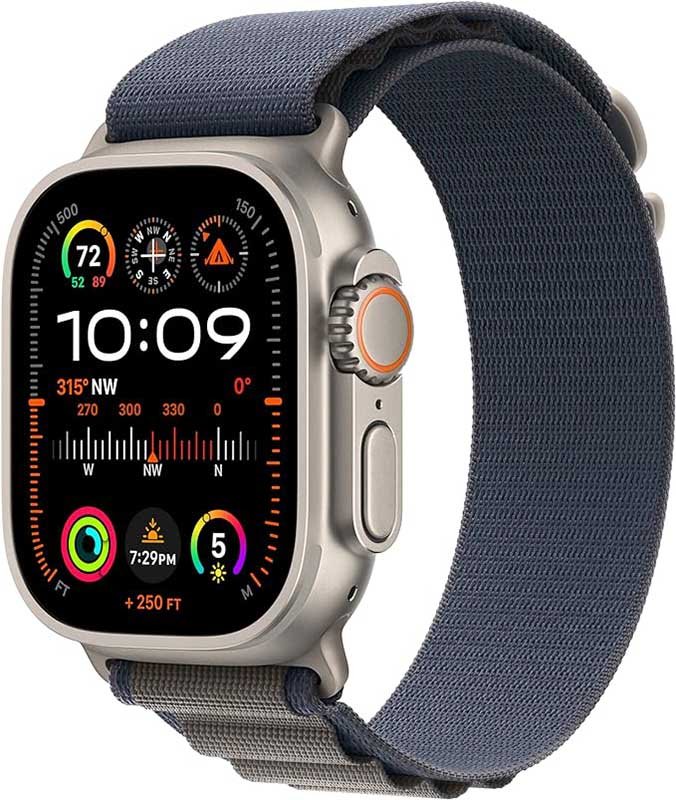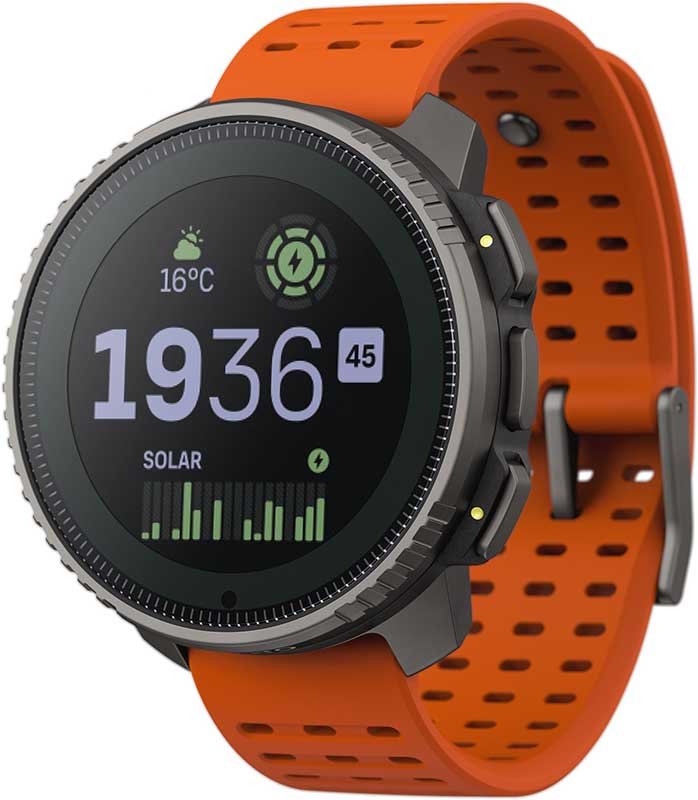Best Hiking Watches for 2024
A GPS watch is a handy tool to have if you plan on going thru-hiking or on a long-distance hike. A good quality hiking watch will show you not only your time and distance but it will also have an assortment of features to let you know that you’re headed in the right direction.
Videos by Outdoors
What makes a hiking watch different from a running watch or a fitness tracker are navigational features such as an altimeter, barometer, compass, and topographical maps. It also has an extended battery life. The latter is probably the most desired trait of a GPS watch for hiking.
For this guide, we reviewed lists and recommendations from an assortment of publications, blogs, vlogs, social media channels, and manufacturer websites. We also narrowed our selection by focusing on products dubbed hiking or adventure watches to pick out the best hiking watches.
Our top pick for the best hiking watch is the Garmin Fenix 7 Pro for its 73-hour battery life and the small, but intentional upgrades from the previous generations produced by Garmin.
Best Hiking Watches
Best Overall: Garmin Fenix 7 Pro Solar – $799.99

If you want to fully invest in your outdoor or active lifestyle, the Garmin Fenix 7 Pro Solar is the watch for you. It’s the latest variation of the Fenix series and while some describe it as merely an incremental upgrade to the Fenix 6, those changes do make a difference.
In terms of functionality, the Garmin Fenix 7 watch only offers a little bit more than the prior model, but it’s the accumulation of the things that Garmin fans love about Garmin multi-sport watches — navigation, health tracking, training tools, storage, etc.
You can also program it to automatically adjust activities and get metrics on your performance, so you can analyze your endurance or hill running, and get real-time weather predictions as well.
The most noticeable new feature, though, is the flashlight. While some may initially dismiss the idea of an integrated flashlight on a watch, it was one of the most requested upgrades. And it serves two practical purposes;
First, you can use it like a flashlight and second, it’s a safety tool. The light mimics car lights in a way. In the front, it shines white light and in the back, it shines red light. However, you can set the light color for your liking (red is not as harsh on your eyes) or use it as an emergency strobe.
What makes the Garmin Fenix 7 better than older models are upgraded sensors, specifically a new and improved heart rate sensor.
The upgrade improves monitoring during activities that require more wrist movement, which may allow outside light to reach the optical sensor. The result is more accurate measurements.
According to the specs sheet, the Garmin Fenix 7 has 22 days of battery life in smartwatch mode and 73 hours of battery life in GPS mode after a three-hour solar charging.
Best Value: Coros Pace 3 – $229

The Coros Pace 3 has been described as not only Coros’s best value watch but probably Coros’s best watch.
The company takes a no-frills approach to product design, so you’ll get everything you need and nothing you don’t. With that said, what it does provide is exceptional accuracy for the heart rate monitor and GPS tracking. It also has a fantastic batter life.
Compared to a Garmin or Apple Watch, the Coros Pace 3 is extremely simple to use as you can scroll through applications using the touchscreen watch face or scroll wheel.
Plus, it’s equipped with a breadcrumb trail navigation feature, which makes following the map super easy because it guides you to specific points on a course and notifies you when you’re off course.
The battery life of the Coros Pace 3 varies depending on how you use the watch and where. In smartwatch mode, the battery will last you 17 days and it’ll charge in less than two hours.
However, you get 41 hours of battery life in GPS mode and roughly 11 hours in GPS mode if you listen to music. If you connect to other satellite systems, you get approximately 15 to 25 hours of battery life and seven to nine hours if you listen to music.
Most Watch Features: Apple Watch Ultra 2 – $799

The Apple Watch Ultra 2 is the newest Apple watch and it was specifically upgraded with the outdoor enthusiast in mind.
If you love Apple products then you’ll probably love the Apple Watch Ultra 2. Compared to the older model, the Ultra 2 has a variety of hardware and software upgrades, which expands controls and applications.
What’s great about the Apple Watch Ultra 2 is the ease of use that comes with Apple products — things such as double-tap answering and Siri assistance — as well as the cellular connectivity.
Most hiking watches rely primarily on GPS for navigation and smartphone pairing for updates, but the Apple Watch Ultra 2 connects with cellular service (for additional fees on your phone plan, of course).
While internet access is not entirely necessary for outdoor adventures, it is helpful as you can communicate in real-time and navigate with greater precision.
Plus, Apple’s app store has a wide range of options for sports and activities. So you get an iPhone on your wrist. Again, you don’t need cellular service but it’s nice to have.
The main criticism of this watch is that it has a shorter battery life than most other GPS watches, which means it lasts between 36 and 72 hours depending on use.
While that’s significantly less than offerings from the previous two brands, Apple is operating with the understanding that you’re okay with charging your watch each night.
Exceptional Battery Life: Suunto Vertical Titanium Solar – $839

With up to 90 hours of GPS tracking, the Suunto Vertical Titanium Solar has exceptional battery life. Although there are many similarities to the Suunto 9 Peak Pro, Suunto refined four specific areas: offline maps, GPS accuracy, solar charging, and battery life.
The navigation tools are considered a huge plus, especially because you can download maps for free using the Suunto app. Plus, the maps are incredibly detailed and you can interact with the map via the watch face touch screen or buttons.
However, the maps aren’t labeled and are instead supposed to be used for context. Still, you can create a route using your phone. Additionally, the Suunto Vertical has improved GPS accuracy as it can use multiple frequencies (multi-band GPS) to track your location.
You can get about 30 days of use out of the watch with a single charge. But, if the watch gets enough sun exposure each day, battery life can last as long as 60 days. But that’s easy. In GPS mode and training modes, the watch will run for up to 60 hours on a single charge and up to 85 hours with solar.
Additionally, the GPS watch has variations of low power mode for a longer battery life. With endurance mode, which operates using a single GPS band, you can get 90 to 140 hours of use depending on solar power, and ultra mode for 140 to 280 hours of battery life.
How We Tested
For this review, we considered GPS watches marketed as adventure or hiking watches that are currently available and because of that, we narrowed our options considerably. There are only a handful of companies that make hiking watches. These include Garmin, Coros, Suunto, and now Apple.
The way we found and ranked the best GPS watches is we looked at a variety of reviews by independent publications and channels as well as materials provided by retailers and manufacturers.
As mentioned before, we also focused on specific qualities like the longest battery life and whether or not it’s used for GPS hiking.
GPS Watch Brands
Garmin
If you do any sort of research into hiking watches or GPS watches, Garmin might be the first thing you see.
Early on, the American and Swiss companies developed GPS navigation systems for a variety of activities like driving, boating, aviation, and land navigation, but eventually ventured into “wearables,” which is another way of referring to smartwatches.
Today, you can find a ton of models, including the Garmin Fenix, Garmin Instinct (Garmin Instinct 2 and Garmin Instinct 2 Solar), Garmin Forerunner, and others.
If you buy a Garmin watch, you’ll have to sync it with the Garmin Connect app on your smartphone for things like maps or in-depth performance monitoring.
Coros
Coros Wearables started as a performance sports technology company in 2014 to make gear for endurance athletes. The company rolled out its first GPS watch in 2018 with its flagship model the Coros Pace. The company’s watches are known for their no-frills design and outstanding battery life.
Suunto
The Finnish-based Suunto is a historic watch and navigation company. Throughout its history, Suunto has specialized in making dive watches and compasses, but today, it’s also known for making outdoor gear like its ABC watch (Altimeter Barometer Compass) and GPS watches.
Apple
The Apple Watch may not need any introduction. The California-based company introduced it in 2015, fulfilling the prophecy set by Dick Tracy decades earlier, but the Apple Watch was by no means a hiking watch.
That is until the Apple Watch Ultra was introduced. It not only had a GPS feature but also internet connectivity and it just got better and better with the Apple Watch Ultra 2.
Features of a Hiking Watch
While there are so many watch features we could talk about, we decided to focus on the ones that make a GPS watch a hiking watch. These include features like battery life, GPS tracking and GPS accuracy, maps, and altimeter, barometer, compass features.
Battery Life
Traditional watches are powered using one of three options: a replaceable watch battery, kinetic energy, or solar charging.
A smartwatch needs a tremendous amount of energy to operate all the features that make it functional, such as GPS tracking, music storage, sleep tracking, fitness tracking, and other advanced features. Therefore, most smartwatch makers equip their designs with a rechargeable lithium-ion battery.
When it comes to smartwatches, there are two important things to understand about battery life;
First, the battery is the heart of a smartwatch. Once it dies, you’ll need to recharge it or it won’t work.
Second, most smartwatches have impressive battery life, but smartwatch features use energy, so the more features you use, the shorter the battery life. Therefore, smartwatch makers offer two measurements of battery life: smartwatch mode and GPS tracking mode.
The reason for the distinction is GPS tracking requires a lot of energy. So in smartwatch mode, battery life is measured in days but most can survive on a single charge for weeks. GPS mode, on the other hand, is measured in hours, with some lasting up to several days or longer with solar charging.
In short, if you plan on tracking your distance and time on long hikes, you will want a smartwatch with not just a long battery life but a long GPS battery life.
With that said, most smartwatches are programmed with a battery saver watch mode or low power mode, which extends battery life. It allows you to turn off smart features like notifications and other basic features so you can prioritize GPS and navigation while you’re in the field.
Additionally, brands also compete on recharging time. Some companies claim their watches will reach a full charge in as little as two hours.
Since we mentioned solar power, some smartwatches are equipped with solar charging sensors, so they charge while you’re wearing it, but that won’t be the only charging option because of the amount of energy needed to power the watch.
Lastly, a smartwatch battery like all batteries will wear out over time. You’ll know when your battery is on its last leg because battery life will run out quicker with daily use.
While you could extend battery life by using fewer features throughout the day, experts say smartwatch batteries typically last between two and five years depending on use.
GPS Tracking
Most people know what GPS is even if they don’t know what it is. You probably know it as the map on your phone that tracks your location and gives you directions. And you’re not wrong. That’s an application of GPS functionality.
The other side of that coin is GPS stands for Global Positioning System. It’s a public utility owned and operated by the United States government.
The way it works is a series of satellites in space communicate with equipment on the ground, which allows you to use the service without the internet or additional fees. An example of that equipment is your GPS watch.
It’s important to know what GPS is because other countries use other satellite systems for satellite navigation or satnav.
It’s called Galileo in Europe, Global Navigation Satellite System (GLONASS) in Russia, BeiDou Navigation Satellite System in China, Indian Regional Navigation Satellite System (IRNSS) in India, and Quasi-Zenith Satellite System (QZSS) in Japan.
Technically, GPS will work anywhere in the world, but if you’re in another country, you’ll get greater accuracy if you use that area’s satnav system.
The catch is your GPS watch needs to be compatible with that country’s satellite system, which most hiking watches are, and you’ll need a fully charged battery because it’ll drain the watch’s battery life.
Maps
Most hiking watches come pre-loaded with topo maps that cover a specific area, so you have an easier time staying on a route or trail.
In full GPS tracking mode, your watch will show your exact location on the map. While you could do the same thing with your smartphone, you might not want to carry your smartphone with you or only use it as a backup.
Although we mentioned GPS accuracy already, it becomes a more desired feature if you have to rely on topo maps. While GPS accuracy refers to how precise your device is at measuring your distance, it also refers to your location on a map.
Smartwatch makers like Garmin say their smartwatches can track your location within about 10 feet when there’s a strong GPS signal.
Altimeter, Barometer, Compass
Although an altimeter, barometer, and compass are all different tools, smartwatch companies making hiking watches will package them all together (traditional watchmakers also make analog ABC watch models). If you plan on hiking in remote, mountainous, or rugged terrain, you’ll want all three of them.
Compared to a smartwatch, an altimeter, barometer, and compass are ancient technology, but if it ain’t broken, don’t fix it.
In a smartwatch, the altimeter and barometer (or barometric altimeter) can supplement GPS tracking or be used as an alternative for measuring elevation. And a compass is just good to have because it shows you cardinal directions.
The altimeter sensor measures elevation changes from a fixed level while a barometer shows altitude based on the corresponding atmospheric pressure. These measurements allow you to see your elevation in real time, which GPS cannot provide.
A barometer will also help you predict short-term weather changes because pressure changes, specifically a sudden pressure drop, indicate rain.
Other Smart Features
While we listed the smart features you should prioritize if you’re looking for a hiking watch, other features to consider include health tracking features like a heart rate monitor, water resistance, touch screen functionality, pedometer (step counter), BlueTooth connectivity, music storage, and multiple activity tracking, meaning things like running, swimming, golfing, etc.
Price
While adventure watches range in price from $200 to more than $1,000, on paper, they’re equipped with very similar features and specs, which makes it difficult to tell the difference. However, there are differences.
Matt LeGrand, a triathlete and tech enthusiast, explained in a recent video that the price of a multi-sport watch used to be on the more expensive side, but those are almost basic options now. What increases the price of a GPS watch now are the materials used to construct the watch and the automated features.
For instance, a higher-end smartwatch will be more durable than a less expensive option, so the watch face won’t scratch against a rock or it’ll be more resistant to water. They’ll also be capable of monitoring multiple activities, such as a triathlon, and recording changes in activity without manual interaction.
Lastly, higher-priced watches are also often programmed for improved battery life by automatically making adjustments — turning on and off certain features — to not waste power.
LeGrand added that maps are almost a basic feature, the quality of the map and GPS accuracy tends to increase alongside the price of the watch. He said watches with a reliable map system tend to start at around $500.
Frequently Asked Questions About GPS Watches
What is a GPS watch good for?
The best use of a GPS watch is for tracking your distance.
Initially, it was ideal for runners to record their mileage during training, but the device has become almost synonymous with health tracking, and more often than not, running is just one of many activities a GPS watch is programmed for tracking.
Do GPS watches work everywhere?
Pretty much. A GPS watch connects to satellite systems in space to track your location. Companies that make GPS watches combine the navigational tool with maps, timers, altimeters, barometers, compasses, and other tools for greater precision and features.
Do you need a smartphone for a GPS watch?
No. GPS watches connect to satellite systems in space. However, you’ll need to pair your watch with the watch brand’s application for software upgrades, data analysis, and downloading maps.
For example, the application might be the Garmin Connect app or iTunes. However, there are third-party apps like Strava that can also connect and pull data from a GPS watch.
Can GPS watch work without the internet?
Yes. The GPS function on a GPS watch will work without the internet, but you’ll need to access the internet for other things like updating software, data analysis, or downloading maps.
How accurate is the distance on a GPS watch?
According to the federal government, GPS is accurate to within about 16 feet, but for tracking, it depends on factors like GPS connection (does your watch have a multi band GPS?), coverage area, topography, speed, weather, distance, etc. While GPS tracking can be accurate, it just depends.
What is the best GPS watch brand?
In this article, we mentioned four GPS watch brands, including Garmin, Coros, Suunto, and Apple. But there are so many GPS watches and smartwatches available today by a variety of brands. Still, Garmin is one of the most prolific and well-known GPS watch brands.
With that said, the best GPS watch is the one that best serves your needs. If you need the watch for health tracking or sleep tracking features, a great GPS watch would be the Garmin Instinct or Apple Watch because they offer baseline and other advanced features at an affordable price point.
Do any GPS watches have unlimited battery life?
Sort of. The closest thing to unlimited battery life in a GPS watch is one with solar charging. That’s why some of the best GPS watches are equipped with solar charging sensors.
With them, the watch will charge under direct sunlight while it’s in GPS track mode, which uses a lot of power. The best GPS watches will also be programmed with low power mode to deliver excellent battery life.
The Best Hiking Watches
If you’re looking to buy your first GPS hiking watch and you do a lot of hiking, you can’t go wrong with the Garmin Fenix 7. But if you’re on a budget, the Coros Pace 3 is also a great option.






